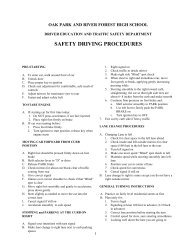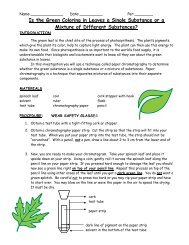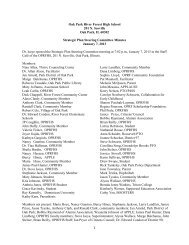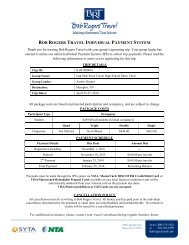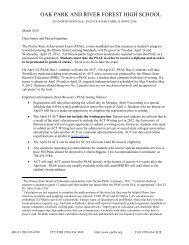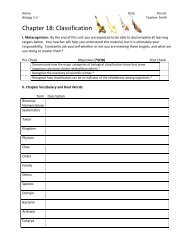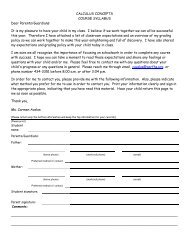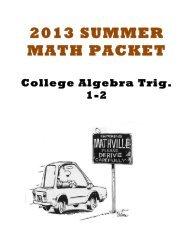Create successful ePaper yourself
Turn your PDF publications into a flip-book with our unique Google optimized e-Paper software.
<strong>SUMMER</strong><strong>MATH</strong> <strong>PACKET</strong>Advanced AlgebraF 1-2Arequired
<strong>MATH</strong> <strong>SUMMER</strong> <strong>PACKET</strong>INSTRUCTIONSAttached you will find a packet of exciting math problems for your enjoyment over thesummer. The purpose of the summer packet is to review the topics you have alreadymastered in math and to make sure that you are prepared for the class you are about toenter.The packet contains a brief summary and explanation of the topics so you don’t need toworry if you don’t have your math book. You will find many sample problems, which wouldbe great practice for you before you try your own problems. The explanations aredivided into sections to match the sample problems so you should be able to referencethe examples easily.This packet will be due the second day of class. All of your hard work will receivecredit. The answers are provided in the back of the packet; however, you must show anamount of work appropriate to each problem in order to receive credit. If you areunsure of how much work to show, let the sample problems be your guide. You will havean opportunity to show off your skills during the first week when your class takes a quizon the material in the packet.This packet is to help you maximize your previous math courses and to make sure thateveryone is starting off on an even playing field on the first day of school. If you feelthat you need additional help on one or two topics, you may want to try math websitessuch as: www.mathforum.org or www.askjeeves.com. Math teachers will be available forassistance at the high school the week before school. Check the school website forspecific dates and times.Enjoy your summer and don’t forget about the packet. August will be here before you know it!If you lose your packet, you will be able to access the packets on-line at the school website,www.oprfhs.org starting May 18th. Extra copies may be available in the OPRFHS bookstore.See you in August!The OPRFHS Math DepartmentI understand that the purpose of the summer packet is to review the topics my students hasalready mastered in math and to prepare for the next course.(Parent/Guardian Signature) _______________________________________________(Date) ______________________1
<strong>SUMMER</strong> <strong>PACKET</strong>For Students Entering AAFNameWelcome to Algebra! This packet contains the topics that you have learned in your previous courses thatare most important to this class. This packet is meant as a REVIEW. Please read the information, do thesample problems and be prepared to turn this in when school begins again.Enjoy your summer!I. Using your graphing calculator: (A TI-Nspire or TI-Nspire CX is required for this class.)• Be able to perform basic operations on a graphing calculator including addition, subtraction,multiplication and division.• Have an understanding of the order of operations and use parenthesis correctly.To enter ( − 2) 2= 4 your keystrokes must include the parenthesis.( ) 2 2− 3 = 9 where as − 3 =− 9• Be able to graph lines on the graphing calculator.1. Use the y= button and enter the lineY1 = 2x− 3. Your graph should look like the onebelow.2. When graphing lines with slope equal to afraction be sure to enter the equation, usingparenthesis. Graph1Y1 = (1/ 4) x−31Y = x− 3 by entering42
III. Functions• Be familiar with function notation. Know that y = x can be written in function notation asf ( x)= x. Given a function, be able to find the values of f ( x ).Problem: Given ( )2af x = 2x− 3, find each of the following:( )( )2) f 0 = 2⋅0 − 3=3b) f 2 = 2⋅4− 3= 9− 3=5( ) ( )c) f − 3 = 2⋅ −3 − 3= 18− 3=152• Be able to identify the domain and range from a set of ordered pairs or from a graph. The domainis the set of all first members in a relation and the range is the set of all second members in arelation.Problem: List the domain and range of the following relation:{ 5, 2 , 6, 4 , 8,6( ) ( ) ( ) }Domain {5, 6,8} Range {2, 4,6}1.Problem: List the domain and range of the following relation:2.Domain: All real numbersRange: y ≥− 3Domain: { − 2,3,4}Range: {3, − 1, 4}4
Problem: Given the graph below, determine the equation of the line.10 1) The y-intercept is –1, so b =− 18642-10 -8 -6 -4 -2 2 4 6 8 10-2-4-6-8-102) Starting with the y-intercept of –1, move up3 units and right 4 units to the next exactpoint on the graph. This would be the point( 4, 2 )3) The change in the y value is 3 in the positivedirection and the change in the x value is 4in the positive direction. Therefore theslope is3m =44) Using the slope intercept equation andsubstituting the values of mandb into3y = mx+ b ⎯⎯⎯⎯→ y= x−14• Graph absolute value functions using a table of values or by splitting the equation into it’s twoparts.( )( )x≥ 0, f x = xx≤ 0, f x =−xProblem: Be able to graph the absolute value equation y x 1points AND by graphing the 2 separate equations below.= + by making an x-y table and plottingMaking a table of values and plotting points:y = x + 1, for all y ≥0y =−x −1, for all y ≥0xy-4 3-3 2-2 1-1 00 11 22 36
• Graph parabolic functions and absolute value functions and be able to translate (or shift) thef x = xgraph of ( )22Problem: Given the parent function f ( x) = x translate the given functions accordingly.f x= x−2** ( ) ( ) 2f x= x − 3** ( )2Where the graph shifted 2 units to the right.Where the graph shifted 3 units down.** f ( x) = x+ 3** f ( x) = x + 1IV. Systems of Equations• Solve systems of equations by graphing.y− x=1Problem: Solve graphically:y+ x=3Solving both equations for y and graphing yields:Solving for yy = x+1y =− x+3Graph(see graph on right)The solution to the system is ( 1, 2 ) , which is thepoint where the two lines intersect.7
Solve systems of equations by substitution. In the substitution method you must get one variableof either equation by itself. Then substitute its value into the second equation.Problem: Solve using substitution.2x+ y = 63x+ 4y= 4Solve the first equation for y. y= 6−2xSince y and 6− 2x are equivalent, substitute 6− 2x for y into the second equation.( x)3x+ 4 6− 2 = 4Use the distributive property. 3x+ 24 − 8x=4Solve for x . x = 4Substitute 4 for x in either equation and solve for y .2x+ y=62⋅ 4+ y = 6y =− 2The solution is the ordered pair ( 4, − 2)• Solve systems of equations by linear combination, which is a combination of linear equations thatwill eliminate a variable. When using this method, first put the equation in the form ofAx + By = C . Make sure the coefficients of either variable are opposites of each other. Addboth equations together.Problem: Solve using linear combination:− 4y=−3x−12y= 3x3x−4y= −1+ − 3x+ 2y= 0Put in Ax + By = C form__________________ Add the x ' s and add the y ' s− 2y= −1Solving for y yields:SubstituteSolve for :1y = .21y = into either of the two original equations:21x =3The solution is the ordered pair⎛⎛⎜⎜⎝⎝1 1 ,3 2⎞⎞⎟⎟⎠⎠⎛⎛1⎞⎞− 3x+ 2⎜⎜⎟⎟=0⎝⎝2⎠⎠8
V. Properties of Exponents• Be able to multiply same bases using properties of exponents, divide same bases and raise apower to a power. Know the following properties of exponents:For any real number a and integers mandnmm n m+ n a m−na a = a = a , a ≠0nam( a )n( )= am⋅nmm npmp np⎛⎛a⎞⎞ aab = a b⎜⎜ n ⎟⎟ =⎝⎝ b ⎠⎠ b1 0a = a ** a = 1−m1 1** a = ** = am−maaSimplify exponents using the order of operations.Problems:** d)VI. Factoring( )( )a) − 3x 5x =−15x( )4 7 114 1116xyb) =−2xy3 9−8xy2 348 12c) 3x y = 81x y−3 −3 −3 −392( )⎛⎛ x ⎞⎞ ⎛⎛ x ⎞⎞ x⎜⎜ x y4 ⎟⎟ = 4( −3)= =−12y ⎜⎜ y ⎟⎟⎝⎝ ⎠⎠ ⎝⎝ ⎠⎠ y9 12pmmpnp• Be able to factor without using your calculator.• Factor terms with a greatest common factor (GCF).4 3 3 3 3Problem: Factor 5x − 20x = 5x ⋅x−5x⋅ 45x is the GCF( )35x x− 4• Factor trinomials of the formProblem:x22x + bx+c−3x−10FactorOne way to do this is to:Look for pairs of integers whose product is -10 and whose sum is -3.Pairs of factorswhose product is -10Sum of factorswhose sum is -3-2 ,5 32, -5 -310, -1 9-10, 1 -9The desired integers are 2 and -5.( )( )2x x x x−3 − 10= + 2 − 59
• Factor trinomials of the form2ax + bx + c23x+ 5x+2Problem: FactorLook for pairs of numbers who product is 3 and then for pairs of numbers whoseproduct is 2. Trial and error yields: 3x 2 + 5x+ 2= ( 3x+ 2)( x+1)• Factor the difference of two squares.Use: a 2 − b 2 = ( a+ b)( a−b)Problem: Factor x 2 − 16 = ( x+ 4)( x−4)Factor 4x 2 − 9= ( 2x+ 3)( 2x−3)• Factor perfect trinomial squaresUse:( )2 2a + 2ab+ b = a+b( )2 2a − 2ab+ b = a−b2Problem: Factor ( ) 222x − 10x+ 25 = x−52 + 14x+ 49= x+72Factor ( ) 2VII. Solving quadratic equations• Solve quadratic equations by factoring (you need to be able to do this without using yourcalculator) and be able to use the quadratic formula.Problem: Solve the following quadratic by factoring.x2−5x− 14=0( )( )x − 7 x + 2 = 0Factorx − 7= 0 or x + 2=0Set equal to zerox = 7 or x =−2SolveProblem: Solve using the quadratic formula:23x+ 5x+ 1=0a= 3, b= 5, c=1Using the quadratic formula and simplifying:− ± − ⋅ ⋅x =23 ⋅The solutions are:25 5 4 3 1− 5+13 −5−13x= and x=6 62− b±b −4acx= , a≠02a10
VIII. Simplifying radicals• Simplify radicals.Know how to use the following theorems:a⋅ b = a⋅bProblem:ab =aba) 50 = 25⋅ 2 = 25 ⋅ 2 = 5 2b a a a2 2 2) 147 = 7 ⋅3⋅ = 7 3• Add, subtract, multiply and divide radicalsAdd and subtract like terms.Problems:a) 3 6 = 3⋅ 6 = 18 = 3 22 2 3b) 3x y 18x = 3⋅18⋅x ⋅x⋅ y = 54x y = 3 x 6xy80 80c) = = 16 = 45 5d)4ab32 a=b4 2e) 6 3+ 2 3 = 8 3f ) 14 2 − 6 2 = 8 2a• Rationalize the denominator. It is standard procedure to write a radical expression withoutradicals in the denominator. This process is called rationalizing the denominator.Problem:2 2 3 3= ⋅Multiply by 1 in form of3 3 3 3==63632Simplify11
Sample ProblemsComplete the problems below, showing work where necessary. Feel free to do your work on separatesheets of paper which you should attach. Remember you will be required to turn this in. An answer key isprovided for you, but in math class, the work is equally as important as the answer!II.Solve the following equations and inequalities. Graph the solution to the inequalities onthe number line.1. 9y7y42− = 2. 27 = 9( 5y− 2)3. ( x ) ( x )5+ 2 − 3 = 2[5− 4 + 2 ]4.3 1− x + = − 24 83 x 5 x 13 x 2 55. + − − =2 3 6 3 66. − 9x+ 3x≥ − 2412
7. 43 ( y−2) ≥ 92 ( y+5)8. 5x + 2 = 79. 7 z + 2=1610. 5−2 3x− 4 = − 511. x ≥ 312. x < 213
13. x − 3 < 514. 3a − 4 + 2≥8III. Functions15. Determine whether the following are functions. If the relation is a function, state the domain andrange:a) {2, ( −3, ) ( 7,9, ) ( − 11,13, ) ( 2,6} )b) {1,19 ( ),( −2,11 ),( 6, − 9 ),( 7,11} )16. State whether the following are functions. If they are the graphs of a function,determine the domain and range.a) b)14
Using your knowledge of linear functions, answer the following questions.17. Graph the following using the slope and y-intercept.a)4y = x+25b) 2x+ 3y= 618. Find the slope of the line containing the following points. ( 8,7) and ( 2, − 1)19. Find a linear function whose graph has the given slope and y-intercept.Slope of34− , and a y-intercept of ( 0,9 )20. Given the points ( 3,3) and ( 3, 7)− find the following:a) the equation of the line in slope-intercept form.b) the equation of the line in standard form15
21. What is the equation in slope-intercept form of the line graphed below.Using your knowledge of functions, graph 22-24 on the axis provided.22. f ( x) = x + 2 −3223. f ( x) = x24. ( ) ( ) 2f x =− x+ 1 + 416
f x = 2x− 3.25. Evaluate the following for ( )2a) f ( 3)b) f ( 0)c) f ( − 2)IV.Systems of equationsSolve the following systems of equations by graphing.26.x− y = 3x+ y = 527.1y =− x−134x− 3y= 1817
Solve the following by substitution.28.y = 5−4x2x− 3y= 139 x− 2 y = 329.3x− y = 6Solve the following using linear combination.30.x+ 3y= 7− x+ 4y= 731.5x−7y= −162x+ 8y= 2618
V. Properties of Exponents32. Multiply the following:3 5a) x ⋅ xb)4a⋅ 7a3 95 46 5 4 7 3c) ( − 2a)( 7a)d) ( mn)( mn p )33. Divide the following:a)aa93b)12t4t27c)m nmn12 94 6d)18xyz−38 6 72 3xyz34. Simplify the following:2a) ( x ) 52 3b) ( 3x y ) 23 5 3c) ( 9m n p ) 32 4d) ( − 2a bc ) 5VI. FactoringFactor the following:335. 3x− 12x36.6xy − 12xy+20xy4 2 3 3 2 519
37.x2+ 2x− 6338.x2+ 8x+1239.22x16x32− + 40.3 2x −x − 72x41.23x16x12− − 42.26x−x−1543.2x − 4944.2x − 16x+6420
VIII. Simplifying radicalsSimplify the following:51. 20 52. 2753. 12 54. 3 7+2 755. 8 2− 6 2+ 5 256. 8 27−3 357. 9 50−4 2Rationalize the denominator58.3259. 3 6 322
Answers:y = 2. y = 1117x =− 4. x =2636. x ≤ 4x =21. 213.5.-5 -4 -3 -2 -1 0 1 2 3 4 5 67.y ≤−5368.9x= 1 or x= −50 1 2 3 4 5 6 7 8 9 109. z =± 211. x≥3 or x≤ − 3110. x =− or x = 3312. − 2< x < 2-5 -4 -3 -2 -1 0 1 2 3 4 5 6-5 -4 -3 -2 -1 0 1 2 3 4 5 613. x < 8 and x >− 2 also14.10 2a≥ and a≤ −3 30 1 2 3 4 5 6 7 8 9 10-5 -4 -3 -2 -1 0 1 2 3 4 5 615. a) Relation is NOT a functionb) Relation IS a function16. a) FunctionD : x ∈ ° ( all real numbers)R: y≥−4b) NOT a function17. a) 17. b)18.4m = 19.33y =− x+9423
20. a)2y= x+53b) 2x− 3y=−1521.2y= x−2322.23.24.25. a) 15b) − 3c) 526. ( 4,1 )27. ( 3, − 2)28. ( 2, − 3)29. ( −3, − 15)30. ( 1, 2 )31. ( 1, 3 )832. a) x33. a)b)c)d)6a53t8 3mn− 6x yz6 3 6b)c)d)34. a)b)c)d)1228a9− 14am n p10 12 310x9x y4 69 15 9729m n p10 5 20− 32a b c24
35.2( − )3x x 436. 2xy 2 2 ( 3x 2 − 6xy+10y3)3x( x+ 2)( x−2)37. ( x+ 9)( x− 7)38. ( x+ 6)( x+2)39.2( x − x+)2 8 1622( x − 4)x( x− 9)( x+8)41. ( 3x+ 2)( x− 6)42. ( 2x+ 3)( 3x−5)43. ( x+ 7)( x− 7)44. ( ) 240.2( −x−72)x xx − 845. x =−3, − 546. x = 0, 42 48. x = 9, − 547. x = ,2349. x =− 3±105 ± 5750. x =451. 2 5 52. 3 353. 2 3 54. 5 755. 7 2 56. 21 357. 41 259. 3 258.3 2225



